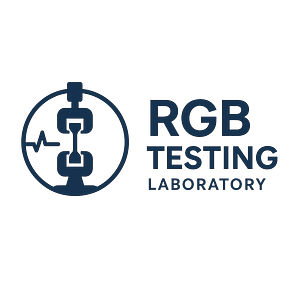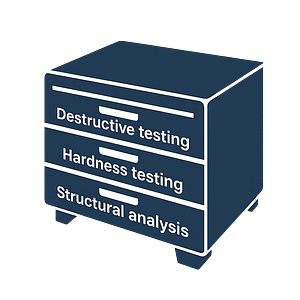Rgb testıng laboratory
Contents
About RGB Testing Laboratory
The RGB Testing Laboratory performs destructive testing of metal materials, welded joints and reinforcement to determine their mechanical characteristics. Tests are carried out in accordance with international standards using modern equipment, which ensures the accuracy and reliability of the results.


Services
- Destructive testing
- Tensile testing (ISO 6892-1, ISO 4136, ISO 15630-1)
- Impact testing (ISO 148-1, ISO 9016)
- Bend testing (ISO 5173)
- Fracture testing (ISO 9017)
- Hardness testing
- Vickers method (ISO 6507-1, ISO 9015-1)
- Structural analysis
- Micro- and macrostructure (ISO 17639)
Mechanical Destructive Testing Methods
- EN ISO 6892-1 – Metallic materials – Tensile testing – Part 1: Method of test at room temperature.
- EN ISO 4136 – Destructive tests on welds in metallic materials – Transverse tensile test.
- EN ISO 15630-1 – Steel for the reinforcement and prestressing of concrete – Test methods – Part 1: Reinforcing bars, rods and wire.


Equipment and Testing Capabilities
- Range of destructive test load: 0.1 kN to 1000 kN
- Tensile and load testing for bolts, nuts and other fastening products up to M45
- Tensile tests for rebars
- Tensile tests for full-size weld joints
- Individual testing options
- Customized load and tensile testing for finished products
- Customized testing tools upon agreement
Downloads
Request a test
Please fill out the online application below or download order form and send e-mail to testlab@rsteel.eu, and our technicians will be in contact with you as soon as possible.
Important Order Information
- Requests are processed within 16 working hours.
- Standard test order processing takes up to 7 working days.
- Urgent orders are accepted based on availability and for an additional fee.
- Specimen return is arranged by the client, otherwise, specimen will be disposed of after two months.
Independence and impartiality
R-Group Baltic OÜ is highly aware of the importance of impartiality in destructive mechanical testing and ensures the independence of its operations.
The company’s management guarantees that all tests are carried out impartially and independently, and the laboratory staff has confirmed their commitment to the principles of impartiality and independence.
We confirm that all information transferred between the company and the client is confidential. Transfer of confidential information is possible only in cases provided by law, as well as at the request of the Estonian Accreditation Centre (EAK) or other authorized bodies in accordance with the requirements of regulatory enactments.
Contact Information
Address: Kõrtsi tee 7/1 (Green Building) Lehmja Küla, Rae Vald, 75306, Harjumaa, Estonia
Email: testlab@rsteel.eu
Working hours: 8:00 – 16:30
For more information, please send an email to testlab@rsteel.eu. Your inquiry will be answered within 24 hours.



